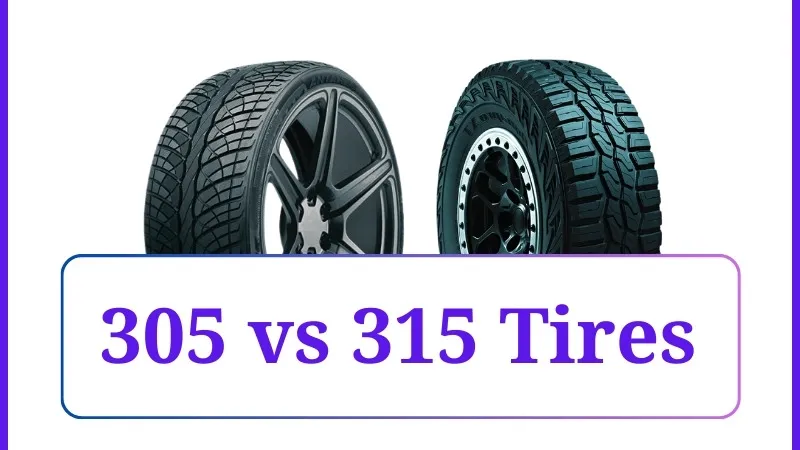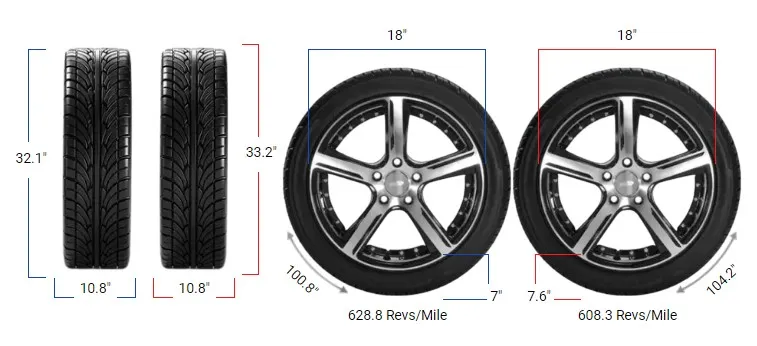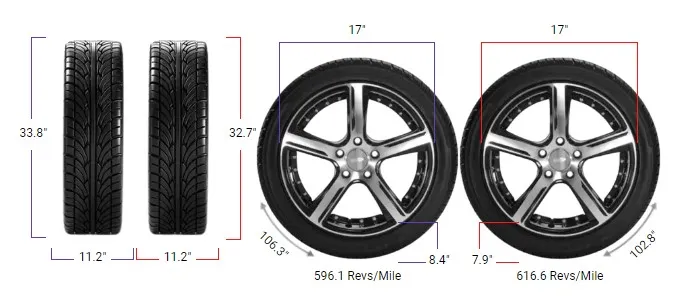305 vs 315 Tires

The difference between 305 and 315 tires lies primarily in their width, as indicated by the first number in their description. The number 305 or 315 represents the width of the tire in millimeters.
As you can imagine, even a small increase in width can affect multiple factors, including handling, traction, and overall performance.
A 305 tire measures 305 millimeters wide, whereas a 315 tire measures 315 millimeters across. This additional 10 millimeters can have both benefits and drawbacks depending on your intended use of the vehicle and the conditions in which you’ll be driving.
305 vs 315 Tires
This in-depth tire size comparison explores the diameter difference by percentage and evaluates if swapping is possible.
| Tire Pair | Difference | Interchangeable |
|---|---|---|
| 305/30R20 vs. 315/35R20 | +5.42% | No |
| 305/70R16 vs. 315/75R16 | +5.44% | No |
| 305/70R17 vs. 315/70R17 | +1.58% | Yes |
| 315/35R17 vs. 305/45R17 | +8.29% | No |
| 315/70R17 vs. 305/70R17 | -1.56% | Yes |
| 315/50R20 vs. 305/55R20 | +2.50% | Yes |
Fitment Guide
When swapping tire sizes, ensuring proper fitment is critical. Both the 305 and 315 tires share the same ideal rim width range:
- 305 Tire: Compatible with rims that are 10.0, 10.5, 11.0, and 11.5 inches wide.
- 315 Tire: Also suitable for rims that are 10.0, 10.5, 11.0, and 11.5 inches wide.
Since the rim width range overlaps, you can switch between these tire sizes on the same set of rims. However, it’s crucial to keep in mind a few conditions before making the swap.

Conditions for a Successful Swap
To ensure a safe and effective tire swap, you need to meet the following conditions:
- Rim Width Compatibility: Both tire sizes need to fit within the same ideal rim width range. Fortunately, the 305 and 315 sizes are compatible, making this swap feasible in terms of rim fitment.
- Aspect Ratio and Diameter Requirements: The aspect ratio (profile height) and rim diameter should remain consistent when swapping tire sizes. If either differs, the overall diameter of the tire must not vary by more than 3%. This limit ensures speedometer accuracy and prevents issues such as rubbing or reduced ground clearance.
Pros of Switching to 315 Tires
- Increased Traction: The extra 10 mm in width results in a larger contact patch, which can improve traction on both paved and off-road surfaces. This is particularly beneficial if you use your vehicle for high-performance or off-roading activities.
- Enhanced Stability: Wider tires can offer better stability, especially when cornering or traveling at high speeds, as the extra width helps distribute weight more evenly.
- Aesthetics: A wider tire provides a more aggressive and sporty stance, which can improve the visual appeal of your vehicle.
Cons of Switching to 315 Tires
- Reduced Fuel Efficiency: Wider tires tend to have more rolling resistance, which can negatively impact fuel economy. If you prioritize efficiency, the increase in width may be a drawback.
- Potential Clearance Issues: Even with the same rim width, wider tires may cause rubbing against the wheel wells or suspension components, particularly if your vehicle lacks sufficient clearance.
- Increased Cost: Generally, wider tires are more expensive, both in terms of purchase cost and potential installation expenses.

Pros of Staying with 305 Tires
- Balanced Performance and Efficiency: Sticking with the 305 size offers a balance between traction and efficiency. The 305 tire provides adequate grip while maintaining better fuel efficiency compared to its wider counterpart.
- Reduced Risk of Fitment Issues: With the 305 tire, you minimize the chance of clearance problems, ensuring smooth operation without additional adjustments to your vehicle’s suspension or wheel wells.
- Cost-Effectiveness: 305 tires tend to be more budget-friendly, and by keeping your current size, you avoid the need for other modifications that may come with a size upgrade.
Cons of Staying with 305 Tires
- Limited Traction Improvement: While the 305 tire provides adequate traction for most conditions, it may fall short in high-performance or off-road scenarios where wider tires could excel.
- Aesthetic Considerations: A slightly narrower tire may not have the same visual impact as a 315 tire, especially if you want a bolder, more muscular look for your vehicle.

Speedometer Impact
Switching between 305 and 315 tires can affect the accuracy of your vehicle’s speedometer and odometer. Any change in the overall diameter of the tire will impact the speed and distance readings.
If the overall diameter difference exceeds 3%, recalibration of the speedometer may be necessary to maintain accurate readings and ensure optimal performance.
Difference Between 305 and 315 Tires
The main difference between 305 and 315 tires is their width. The 315 tires are 10 mm wider than 305 tires.
Both tires share the same ideal rim width range of 10.0″ to 11.5″, which allows for potential interchangeability if other factors like aspect ratio and rim diameter are compatible. The slight increase in width may affect traction and handling characteristics.
Can I Use 305 Tires Instead of 315?
Yes, you can use 305 tires instead of 315 tires if the ideal rim widths overlap and the aspect ratio and rim diameter are the same.
Since both tires share the same ideal rim width range of 10.0″ to 11.5″, swapping is feasible. Ensure that the overall diameter difference is within 3% to maintain performance and safety.
Can I Use 315 Tires Instead of 305?
Yes, you can use 315 tires instead of 305 tires if they share overlapping ideal rim widths and have the same aspect ratio and rim diameter.
The shared ideal rim width range of 10.0″ to 11.5″ allows for this substitution. Verify that the overall diameter difference doesn’t exceed 3% to ensure proper fit and function.

Can You Put 305 Tires on 315 Rims?
Yes, you can put 305 tires on rims designed for 315 tires if the rim width falls within the shared ideal range of 10.0″ to 11.5″.
Make sure the aspect ratio and rim diameter match, or that the overall diameter difference is within 3%, to maintain safety and performance standards.
Can You Put 315 Tires on 305 Rims?
Yes, installing 315 tires on rims meant for 305 tires is possible if the rim width is within the shared ideal range of 10.0″ to 11.5″.
Ensure that the aspect ratio and rim diameter are the same, or that any overall diameter difference is within 3%, to ensure compatibility and safety.
Conclusion
Deciding between 305 and 315 tires depends largely on your driving habits, vehicle use, and personal preferences. If you are looking for enhanced grip, a more aggressive appearance, and improved stability, the 315 tire may be a worthwhile upgrade—provided your vehicle can accommodate the extra width.
On the other hand, if cost, efficiency, and avoiding potential clearance issues are more important to you, sticking with the 305 size might be the better option.
Always make sure to consult a tire expert before making any changes to ensure that your choice meets all safety and performance criteria.
Remember, the right tire size can significantly enhance your driving experience, whether you’re cruising on the highway or tackling rough terrain.



